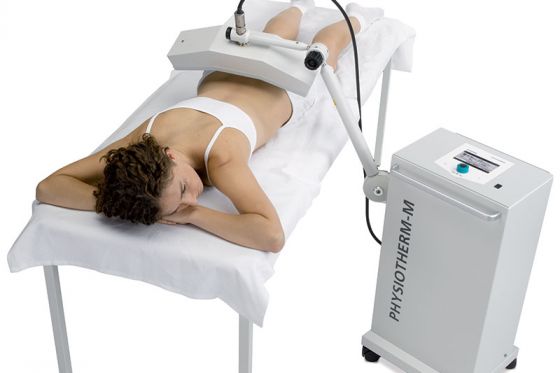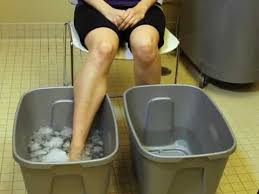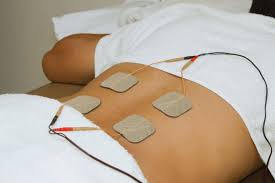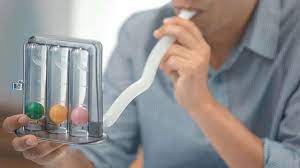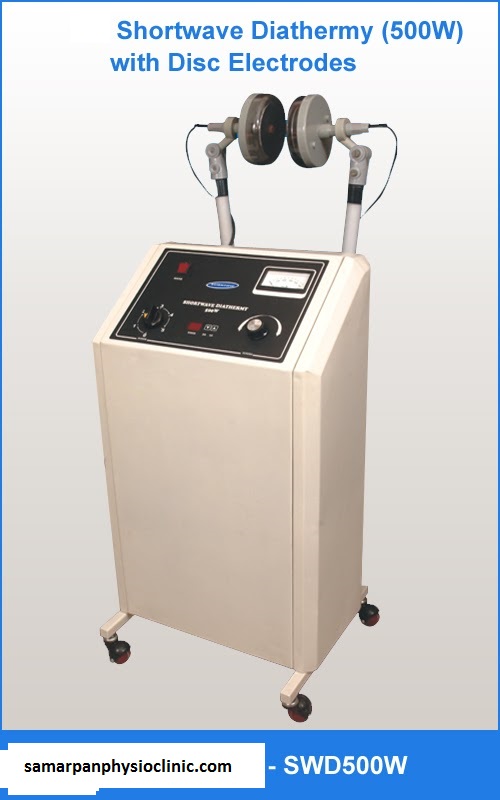MICRO-WAVE DIATHERMY USE IN PHYSIOTHERAPY
Table of Contents
DEFINATION :
microwave diathermy of the tissues with radiation in the shorter wireless part of the electromagnetic spectrum, e.g. with a wavelength between infra-red and short-wave diathermic radiation. there is some variation in defination, but waves of 1-100cm may conveniently be classified as microwave.
WAVELENGTH : 12.25cm
FREQUENCY : 2450 MHz
some use is made of radiation with a wavelength of 69 cm and a frequency of 433.92 MHz. the principal function of the application of microwave to the tissues is to produce a local rise in temperature at the point where they are absorbed.
*PRODUCTION OF MICROWAVE
- wireless waves are produced by high-frequency currents and have the same frequency as the currents which produce them. the principles of production of the currents are similar to those for other high-frequency currents, but in order to obtain the neccessary very high frequency a special type of valve called a magnetron is used as with other valves, the magnetron requires times to warm up so output is not obtained immediately the apparatus is swithched on.
- A stand-by switch should be provided for use between treatment: this enables the output circuit to be disconnected without cutting off the current to the valves, so that repeated heating and cooling of the valves is avoided.
- current must be carried from the high-frequency circuit by a coaxial cable. a coaxial cable consists of a central wire with an outer metal sheath seperated from the wire by insulating material. the wire and the sheath run parallel to each other throughout and form the output and return wires of the circuit. the cable must be of the correct length for the particular frequency.
- the coaxial cable carries the current to a small aerial from which the microwaves are emitted. the aerial is mounted in a reflector, which is packed with some material which transmit the waves, so forming a solid unit. the whole device is used to direct the waves onto the tissues and may be termed the emitter, director or applicator. the patient does not form part of the circuit, which is contructed in such a way that no tuning is necesssary for individual treatments. microwave energy is transmitted as free space radiation, and consequently needs only this one emitter. however , as with any pure electromagnetic radiation the microwaves will be subject to reflection , refraction, interference and absortion.
- as with short-wave diathermy, microwaves can interfere with radio communications, so the generator must be constructed so as to minimize interference, and only specified frequencies may be used for medical work. the frequencies may be used for medical work.
*APPLICATION OF MICROWAVE
- various types of emitter are available. those most commonly used are placed at a distance from the body and the waves pass through the intervening air to reach the tissues. emitters of this type may be circular or rectangular in shape. the circular ones give a beam of rays which is circular in cross-section and is of greatest destiny centrally.
- in both cases the rays given off from the emitter diverge, so that thier destiny becomes less as the distance from the emitter increase. reduction in the intensity of the beam is also caused by absorption of the rays. the distance from the emitter increases. reduction in the intensity of the beam is also caused by absorption of the rays. the distance from the skin at which these emitters are used depends on the particular emitter, the output of the generator and the structure to be treated. commonly it is between 10 and 20 cm. larger areas require a greater distance and a greater distance requires a greater output from the emitter.
- small emitter are made for use in contact with the tissues and for the treatment of cavities, but they do not appear to be as effective as distant emitters. recently an emitter with a concave surface which fits round the body has been used with 69 cm waves. it is claimed that this gives a deeper effect than the other methods.
*PHYSIOLOGICAL EFFECTS OF MICROWAVE
- absorption of the waves results in the production of heat in the tissues, but microwave diathemy differs from other heat treatment in the penetration of the heat. microwaves penetrate more deeply than do infra-red rays, but do not pass right through the tissues in any appreciable density like the electric field used in short-wave diathermy. thus the effects are deeper than those of infra-red irradiation, but less suitable for the treatment of deeply placed structures than short-wave diathemy. the effective depth of penetration of microwaves appears to be about 3cm, but this depends upon the water content of the tissues through which they must pass. with equipment generally available it is possible to irradiate only one aspect of the body at a time.
- microwave are strongly absorbed by water,so there is appreciable heating of tissues which have a good blood supply, such as fat. thus the heating of the subcutaneous fat, which is a disadvantage of short-wave diathermy applied by the condenser field method, is avoided.
*THERAPEUTIC EFFECT OF MICROWAVE
- as the physiological effects of microwave diathermy are similar to those of short-wave diathermy, it can be used in the treatment of the same types of condition: traumatic and inflammatory lesions, in which the increase in blood supply and relief of pain and muscle spasm are of value, and bacterial infections, where the increase in blood supply brings more white blood cells and antibodies to the area and so reinforces the body’s normal defence mechanism.
- microwave diathermy is most likely to be effective for lesions in the superficial tissues and those of high fluid content. it is therefore suitable for the treatment of traumatic and rheumatic conditions affecting the soft tissues and small superficial joints. as it is generally possible to irradiate only one aspect of the body at a time, it is more satisfactory for localized than for widespread conditions. the ease of application may make microwave diathermy preferably to short-wave diathermy in those condition where both are applicaple.
* DANGER OF MICROWAVE DIATHERMY
1)BURNS
microwave diathermy can produce heat burns. the patient’s sensation is the primary guide to the intensity of treatment to apply, so it is unwise to use the method if skin sensation is defective. some authorities calim that the heating of the underlying tissues is greater than that of the skin, but damage should not occur if the dose is limited to that suggested.
water is heated rapidly by the waves, so the skin must be dry. we dressings and adhesive tapes should be avoided, and caution should be exercised with areas which perspire freely. concentration of the waves may cause over-heating where the emitter is unevenly spaced from the tissues. as with short-wave diathermy, metal objects should be removed from field.
*CONTRAINDICATION
- over malignant tissues
2.over ischamic tissues
3.over wet dressing and adhesive tape
4.metal implants
5.pacemaker
6.over growing bone
7.male gonads : repeated irradiation can cause sterility
8.hemorrhage
9.impaired thermal sensation
*DAMAGE TO EQUIPMENT
damage to the megnetron can result from leaving the apparatus on with the emitter facing a metal plate, which reflects the waves. the effect of microwave on electronic devices such as cardiac pacemaker and hearing aids is not known, but it should be assumed that the situation is the same as with short-wave diathermy, and that such devices may be damaged by microwave.
*TECHNIQUE OF APPLICATION
1)PREPARATION OF APPARATUS
the selected emitter is connected to the machine by the appropriate cable and the power switched on. there will be some delay before output is obtained, but then the physiotherapist tests the apparatus by placing her hand or arm in front of the emitter and increasing the output until a sensation of warmth is experienced. the controls are then returned to zero and the switch turned to the stand-up position.
2)PREPARATION OF PATIENT
this is the same as the preparation for the application of short-wave diathermy. the patient must be warned to avoid excessive movement once the emitter has been arranged in position and full support in a comfortable position is necessary to ensure this. the patient is fitted with a pair of wire mesh goggles to protect his eyes.
3) APPLICATION OF EMITTER
the emitter is arranged so that its surface is parallel to the skin and it the appropriate distance, due consideration being given to the surface marking of the structure to be treated. irregular surface and areas which perspire freely should, if possible, be avoided.
*IRRADIATION
the patient is reminded of the sensation to be expected and of the need to repot accurately on that experienced. the output is increased slowely until a sensation of warmth is experienced or the selected output is reached, whichever comes first. irradiation continue for an appropriate time, the physiotherapist visiting the patient frequently to ensure that nothing untoward has occured. the output is then reduced and switched off. slight erythema may be observed, but there should be no marked skin reaction.
*DOSAGE
the dose can be calculated from the pwer output from the machine, which may be up to 200 watts, but in all cases the sensation experienced by the patient must be the primary guide. this should never be more then a comfortable warmth, and as a general rule weaker doses should be used for acute than for chronic conditions. duration of treatment 10 to 30 minutes.

